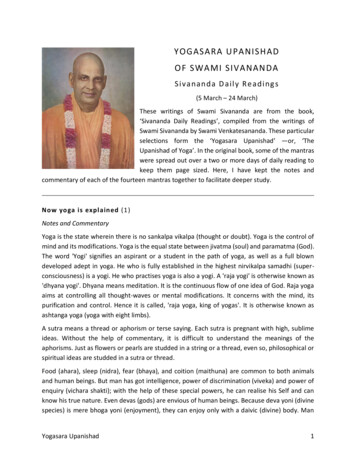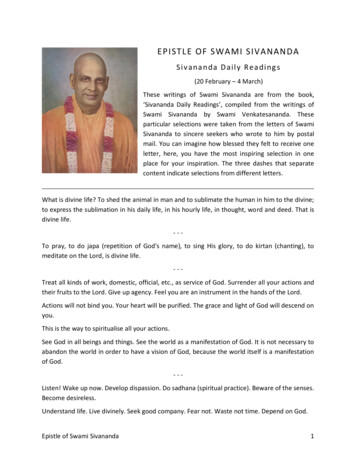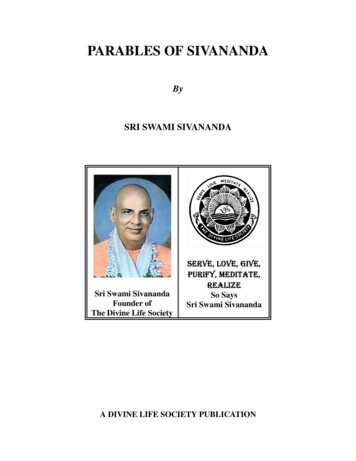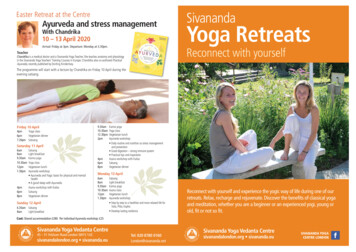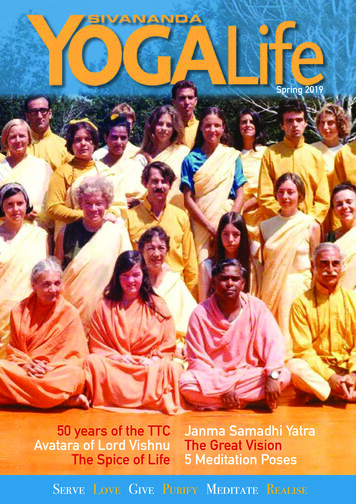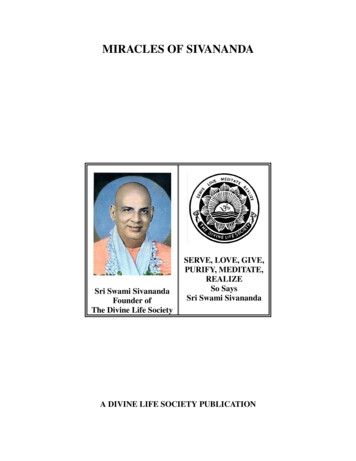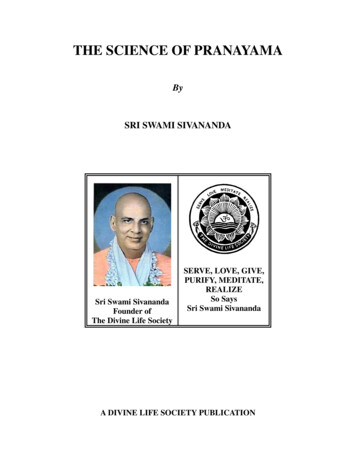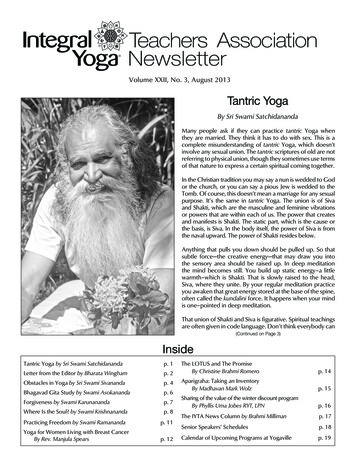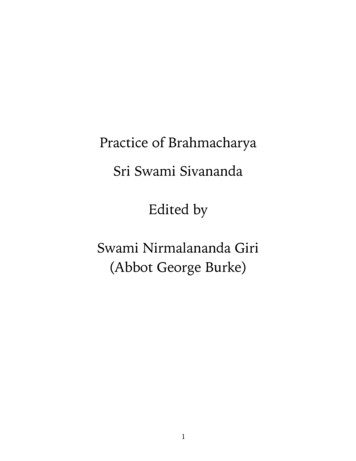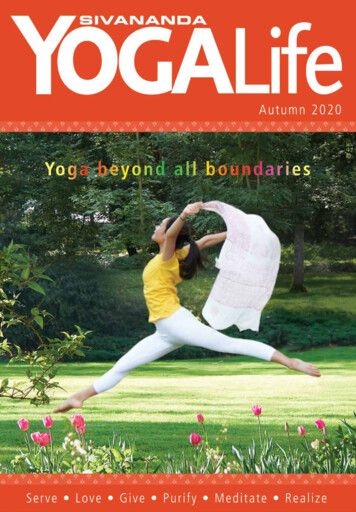
Transcription
International Sivananda Yoga Vedanta CentresSwami Sivananda (1887 - 1963)Swami Vishnudevananda (1927 - 1993)The spiritual strength behindthe Sivananda Yoga VedantaCentres, Swami Sivananda’steachings are a synthesis ofall the formal doctrines ofyoga. Author of more than300 books on yoga, SwamiSivananda was a medical doctor beforerenouncing worldly life for the spiritual path.He founded the Divine Life Society and theYoga-Vedanta Forest Academy,Born in South India in 1927,Swami Vishnudevanandaentered the ashram of SwamiSivananda at the age of 18.Rishikesh, Himalayas. His main message was:Serve, Love, Give, Purify, Meditate, Realise. In1957 he sent one of his foremost disciples,Swami Vishnudevananda to the West to spreadthe ideals of yoga. Swami Sivananda enteredMahasamadhi on July 14th 1963.Editorial Yoga LifeWe are living extraordinary times the COVID-19 pandemic has changed the world in a matterof months, and it seems we are entering a different phase of the world evolution. The successiveA world famous authority onHatha and Raja Yoga, SwamiVishnudevananda founded the InternationalSivananda Yoga Vedanta Centres in 1957 andwas author of The Complete Illustrated Bookof Yoga, Meditation and Mantras, Karma andDisease and a commentary on the Hatha YogaPradipika. Swami Vishnudevananda enteredMahasamadhi on November 9th, 1993.lockdowns have left a strong impression on people’s minds, and many experience its traumaticeffects in the form of stress and anxiety. We pray for peace and strength for the individuals andfamilies who have been affected one way or another by the pandemic. May all keep their faith asfaith can overcome fear and anxiety.With this powerful wave of unrest and fear engulfing the planet, the Acharyas of the Sivananda YogaVedanta centres felt the need to continue bringing the message of peace and unity of yoga to theirstudents.A new way to reach out to the world was quickly put in place: sharing the teachings on line!The response was overwhelming, with hundreds of messages coming from all corners of the planetexpressing gratitude to be able to continue their practice and connect with other practioners in thisway.2020 has also been a year where we receive serious allegations against the Sivananda organizationand its founder, Swami Vishnudevananda.We express our heartfelt compassion to all those who have felt hurt at any time of the history of theThe Executive BoardThe Executive Board of the Sivananda YogaVedanta Centres is comprised of seniordisciples of Swami Vishnudevananda,personally chosen and trained by him to directthe organisation after his departure. Eachof them has had many years’ experience inSivananda Organization. We sincerely hope that a space of deep listening can be created and thatteaching all aspects of yoga. They are renownedfor their devotion to Swami Vishnudevanandaand Swami Sivananda and for their profoundknowledge and inspirational teaching andguidance, wisdom imparted to many thousandsof students throughout the world.this deep and respectful listening can hopefully lead to mutual understanding and healing.The board members themselves, who have and intend to continue to dedicate their lives sharing theteachings they have received, are deeply affected by the trauma that this situation has created formany in the Sivananda community who have been shaken in their faith.We hope that faith can be re-established going forward.We would like to thank the staff, karma yogis and students of the Sivananda organization for theirlove, devotion and continued support.You can contact us via email at EBMsecretary@sivananda.netSwamiSwamiDurgananda Swaroopananda Srinivasan2 YOGALife Autumn 2020SwamiSwamiSwamiSivadasananda Kailasananda SitaramanandaWe wish you all good health, strength and inner peace for the New Year.Kanti DeviOm Shanti, the Acharyas of the Sivananda Yoga Vedanta CentresYOGALife Autumn 20203
YOGALife Summer 2020 ContentsMeditation on the Power of Om by Swami Sivananda4 YOGALife Autumn 20206Who am I by Swami Vishnudevananda10Meet and Greet by Acharya presentations18The Play of the Gunas by Swami Durgananda28Deepening the Yoga Practice by Swami Sivadasananda36The Transforming Power of Meditation by Swami Kailasananda44The Role of a Yoga Teacher during Covid 19 by Swami Sitaramananda52Prayer for World Peace by Swami Sivananda62The Power of Prayer to Help the World by Swami Rajeshwarananda64Perfect Health through Ayurveda by Dr. Sudhindra Uppoor68Why Should We be Vegetarian by Jean James Garreau76Create Your Own Spiritual Power Centre at Home by Swami Bhagavatananda86Yoga LIT Experience by Sivapriya94Yoga for Climate Action by Sivananda Yoga Ranch98Likitha Japa – A Practical Way of Meditation by Swami Jyotirmayananda118Teachers Training Course Online – Testimonials of personal experiences124How to Maintain Mental Health by Swami Sitaramananda126Aspects of Immunity in Ayurveda by Angela Hope-Murray138The Health Benefits of Meditation by Chandrika144Permaculture and Yoga, An Introduction by Jeremy Thompson152Ashram and Centre News160Ashram and Centre Addresses168YOGALife Autumn 20205
MEDITATIONON THEPOWER OF OMFROM THE BOOK: MEDITATION ON OM ANDTHE MANDUKYA UPANISHAD BY SWAMI SIVANANDA”Utter OM in each and every breath of the nose. Be ever wakefulin the bliss of OM. Melt the dream of the illusive world inwakefulness of OM. Sink the pains and miseries of samsara in thebliss of OM, the bliss of the Eternal, the Abode of Peace, Bliss and Joy.As soon as you sit for meditation, chant OMloudly 3 or 6 or 12 times. Again and again,sing the glory of OM. Apply your heart, mindand soul to the music of OM.Perform all actions as an adoration of thesacred pranava. Live and move in OM. MakeOM the centre of your dwelling place.Philosophy of OMThe life of all words is vowels. A vowel is thatwhich shines by itself. It can be pronouncedby itself. A consonant is that which cannotbe pronounced without the help of a vowelplaced either before or after it.A consonant can be sounded with the aidof a vowel. Just as the body depends for itsvery existence on the soul or the Atman, soalso the consonants depend for their verypronunciation on the vowels.‘A’ and ‘U’ are the parents of all othervowels in Sanskrit. Sanskrit possesses a large6 YOGALife Autumn 2020”number of vowels compared to any otherlanguage in the world. All the letters of thealphabets of all languages are contained inthis mysterious, sacred monosyllable OM(AUM). Therefore, it is quite proper to regardOM as the symbol or name of Brahman.Watch the breath. When you inhale, thesound so is produced; when you exhale thesound hum. You are naturally uttering sohamalong with every breath. The breath remindsyou that you are in essence identical with thesupreme Self.In soham, ‘s’ and ‘h’ are consonants. If youdelete the consonants ‘s’ and ‘h’, you getoam or om. Consonants have no indepenceof their own. They depend on vowels fortheir existence. ‘S’ and ‘h’ represent thenames and forms, of this universe which hasonly a dependent existence. OM only is thesolid reality. OM is the soul of your breath.There is what is called pancha-santi, fiveYOGALife Autumn 20207
kinds of incantations, each ending with theword santi or peace. Before each santi thereis the word OM. As such OM gives peace,calmness, tranquillity and serenity. Thissymbol brings the entire universe and allit contains in its span. It means somethingmore, ‘a’ is the first letter of the alphabet and‘m’ is the last syllable in Sanskrit. Thus ‘a’ and‘m mean everything from A to Z.It is the alpha and omega of everything. Itrepresents everything from beginning toend and since there is the other part ‘u’,OM includes everything we can imagineand something more too. As such, it is a fitsymbol to be meditated upon. No othersymbol can span so much in its embrace.Chanting of OMChant OM from the very bottom of yourheart with profound feeling. When chantingOM, knowing its omniscience, omnipotenceand omnipresence, feel that OM gushesforth with its true colour, from every nerve,every vein, every cell, every atom, everymolecule, every electron and the verycorpuscle of your body. Pour forth OMvibrations into the world with mighty vigour,speed, force and strength. Get ready now forrecharging. Now roar like a lion of Vedantaand chant OM.Chant OM for five minutes rhythmically withbhava and understanding as soon as yousit for meditation. Learn its meaning. Thesound should start from the navel and endat the crown of the head. The mysteriousvibrations produced by the chanting of OMwill produce one-pointedness of mind andharmony in the annamaya, pranamaya andmannomaya koshas (food sheath, vital sheathand mental sheath) and make the mind intune with the Infinite.Drive evil thoughts by chanting OM. Drawinspiration, power and strength by singingOM. Get one-pointedness of mind by doingjapa of OM. Melt the mind in Brahman by8 YOGALife Autumn 2020meditating on OM and rest in your own satchid-ananda svarupa. May that OM guideyou, protect you, elevate you, take you to thegoal and free you from the round of birthsand deaths.Whenever you feel depressed, whenever youget a little headache, take a brisk walk adchant OM while walking. While chanting OM,feel that your entire being is filled with divineenergy. Chanting of OM is a potent, easilyavailable tonic and specific for all diseases.OM is a panacea or sovereign remedy forall ailments. Try this prescription yourselfand feel the miraculous effects of this divinemedicine. Just as you take medicine twice orthrice, take recourse of chanting of OM twiceor thrice.Chanting of OM means going near thesource and tapping the cosmic energy thatis inexhaustible. When you chant OM, feel‘All health I am’. All pathogenic or diseasecausing germs are destroyed or burnt by thevibrations of OM. You chant OM while sittingon any comfortable asana in your room forthe purpose of regaining, maintaining orimproving your health.OM with PranayamaYou can associate OM with the breathduring the practice of pranayama. Mentallyrepeat ‘O’ during inhalation and ‘M’ duringexhalation. This will increase the efficacy ofpranayama. This is sagarbha pranayama. Youcan keep OM for constant japa also. Watchthe breath and repeat ‘O’ during inspirationand ‘M’ during expiration. You can do thispractice while walking also. Put sufficientforce into the thoughts of OM.Feel that OM is coming from your soul, thiswill raise your consciousness to a very highplane. You will become one with the soul, theAtman.these three letters ‘A’, ‘U’ and ‘M’. Inhalethe air through the left nostril for the spaceof sixteen matras, meditate on the letter ‘A’during that time. Retain the air for the spaceof 64 matras and meditate on the letter ‘U’during that time. Exhale for the space of 32matras and and meditate on the letter ‘M’during that time.Practise this again and again in the aboveorder. Begin with two or three times andgradually increase the number to 20 to30 times according to your capacity andstrength. To begin with, keep the ration 1:4:2.Gradually increase the ratio t0 16:64:32. Thepractitioner will get great peace of mind andinner strength.Tratak on OMBeginners in the path of jnana yoga shoulddo tratak (gazing) on OM with open eyes inthe beginning for about three months. Thenthey should visualize OM with closed eyes.Visualisation of OM is the calling up of aclear mental image of OM by closing theeyes. They should repeat OM mentally withfeeling and meaning and make the earshear the sound also so that they may not runoutside to hear other sounds.Sweet OMOm is the word of power,Om is the sacred monosyllable,Om is the highest Mantra,Om is the symbol of Brahman,Om is Soham,Om is Om Tat Sat,Om is the source of everything,Om is the womb of the Vedas,Om is the basis of all languages,In Om merge all Trinities,From Om proceed all sounds,In Om exists all objects.O Sweet Om! Potent Pranava!The life of my life,The boat to cross this Samsara,Harbinger of Eternal Bliss,My redeemer and Saviour!Guide me and take meTo Brahman, the hidden sage!Have the picture of OM in front of you inyour meditation room. Concentrate onthis picture. Do tratak also with open eyes.Steady gazing without winking make tearsflow profusely. Associate the ideas of infinity,eternity, immortality etc. when you think ofOM.This is meditation with and withoutattributes. Keep a picture of OM alwaysbefore your mind and do worship. But rnincense, camphor. Offer flowers. This is acombined method of bhakti and jnana.Meditate that the single letter, the supremelight, the pranava, OM is the source ofYOGALife Autumn 20209
WHO AM IPREPARING FOR JNANA YOGA MEDITATIONBY SWAMI VISHNUDEVANANDATaken from an initiation lecture given bySwami Vishnudevananda at the start of theAdvanced Teachers’ Training Course in ValMorin, Canada in 1982.When we come to Jnana Yoga meditationwe begin with the original knowledge, theknowledge which is held in the Vedas.It is said that the Vedas came during theprevious cosmic night when Brahma wasin deep slumber. He himself had beenwithdrawn by the force of time into thesubstratum. That substratum is symbolicallyrepresented as the navel of Lord Vishnu.There, there is a lotus representing thehidden energy, and into that cosmic lotus,the great creator Brahma has been forcedto withdraw and rest in deep, deep cosmicsleep – cosmic nidra.During that time, all of nature that is madeup of the three gunas – sattva, rajas andtamas – is in equilibrium. At that time there isno knowledge: no time, space, or causation.At that time, the Vedas existed only in thememory of the great creator Brahma whois in deep sleep. Just as the knowledgethat we have is still there even when we aresleeping although we are not aware of it untilwe wake up, so it is also with Brahma. Wecan bring that knowledge only when we arein the waking state. In the deep sleep statewhatever knowledge we possess – geometry,philosophy, mathematics, music – all this10 YOGALife Autumn 2020knowledge is hidden in deep sleep and canonly be brought back when we wake fromthe sleep state.It was the same with Brahma, too. In thecosmic night everything is in stand-still, likeour deep sleep. At least during our deepsleep, others might be in the waking stateor in the dreaming state. When we are indarkness, in other parts of the world thereis light. That is not the situation here: herethere is no place where there is day or night,time, or space.There is only stillness, absolute stillness,and as the cosmic night is about to finishits course, at the dawn of the present worldBrahma wakes up, just as we are forced towake up due to our karma. We cannot sleepall day and all night. After several hours weare forced to wake up. It is the same withBrahma also. Due to time, the power of LordVishnu, he himself is forced to wake up fromhis deep cosmic slumber.At the dawn of the previous cosmic night theforces which were in equilibrium, the threeforces of sattva, rajas and tamas are suddenlyactivated, like a tulip bulb which is activatedat the beginning of spring. That tulip bulbwas in deep sleep, in a suspended stateduring the whole winter, but now the energyof the tulip bulb is activated and sends out asmall shoot which eventually becomes a tulipflower with colours, beauty and so on.YOGALife Autumn 202011
That hidden nature – Maha Sakti – becomesactive, just like the tulip flower becomesactive, just like we become active in themorning. The three qualities of nature,sattva, purity; rajas, activity; and tamas,inertia, are no longer in a state of equilibriumand there comes a tremendous oscillation, avibration, and due to the interaction of thesethree qualities Sakti is separated and Brahmais able to see the universe yet to come justlike in a dream, only in the thought state.It exists only in the thought state. He existsonly in a thought in the universe. He hasforgotten the previous creation. He hasforgotten everything that he did. Like withamnesia, he has forgotten the past.Brahma also has cosmic amnesia in thebeginning. He doesn’t know what hispurpose is, what his duty is, what he issupposed to do. But he sees something – avague recollection – but still it is not veryclear at all. As the Sakti is activated and theintensity increases, he is also having theinner urge to find out, first of all his ownsubstratum, the source from where he hascome. He must have a source somewhere.And he looks, and there is only cosmic night– cosmic pralaya.There is nothing there: neither sun, norstars, nor galaxies, nor moon, neither up nordown. But he visualises himself seated on alotus – symbolically representing the energy– and he wants to find out where he hascome from, what is his purpose, and what hehas to do. He has no idea as Sakti has notcompletely manifested. Just like someonewho has just come out of sleep, he doesn’tknow where he is. In that situation Brahmagoes on searching his route.The route is Lord Vishnu, but he doesn’tknow. He goes on searching. He goes on tothe stalk – symbolically again. For thousandsof years he travels, but he still cannot find thebeginning. He comes back again and sits in12 YOGALife Autumn 2020deep meditation and practises pranayama tocreate the sakti. As he does intense penanceand pranayama, then comes the word thathe hears in his inner ear, ‘tapah’, ‘penance’.‘Do penance’.So he goes on doing penance for thousandsof years and then he sees the world yetto come, the type of world he is goingto create, just like an architect can seethe building that he is going to build. Inthe same way, in his cosmic mind he seesthe cosmic universe, the previous cosmicuniverse that he created that has now beendissolved, and the new one which is going tocome, what type of manifestation it is goingto be.So from that cosmic vision that he saw fromwithin the substratum he prays to LordVishnu, and from that he created the world,and from that the four Vedas came. That isthe original knowledge. The Vedas are theoriginal knowledge. From his mouth, theVedas came, the universe came, and theknowledge came.So the Vedas were not created, they existedbefore, just like gravity existed. Gravity wasnot invented by Newton; it was discoveredby Newton. Even before he discoveredgravity, gravity was there – he only realisedits existence. In the same way the Vedaswere there before, but through the mouth ofBrahma and through his first initiation intothis Vedic knowledge we are able to receiveit in this present creation again.And again this universe will dissolve, andin Brahma’s cosmic night he himself will bewithdrawn; all knowledge will be withdrawnback and Brahma will rest again in thiscosmic sleep by the force of Vishnu maya– the maya of Lord Vishnu. In this way theuniverse evolves and dissolves.We can grasp this concept intellectuallyby speaking symbolically, but whatever isunderstood intellectually is not what thiscosmic evolution is, this cosmic dawn, thiscosmic energy, this sakti maya. The originalstate is far beyond our comprehension andso we use these simple stories and thissymbolic language to understand what thecreator and the gunas are.It can be explained, but still, it is far beyondour comprehension. What is evolution, whatis dissolution, what is Brahma, what is thecreator, what is Vishnu, what is Sakti is farbeyond our understanding.Vedanta is the last portion of the Vedasand it is here that the knowledge is stored.Vedanta is the end where there is no moreduality. We want to transcend all duality andreach that infinite oneness with the Supreme.So for us, the important question is, ‘Who amI?’. That is Inquiry. The question ‘Who am I?’is the central question. The next question is,‘Where do I come from?’. Then, ‘Where do Igo?’.Moksha is freedom from births and deaths.It is the attainment of eternal bliss. It hasneither space nor time in itself; nor is there init any state, external or internal. You are bornto attain moksha or the final emancipation.Moksha is your goal. Kill this little ‘I’ oregoism through enquiry of Who am I? Youwill attain moksha and shine as emperor ofthis world. May you attain moksha in this verybirth.Did this ‘I’ just come now? Did it have anypast? Did ‘I’ just come in the middle anddoes it disappear at the end? If so, then wedon’t have to inquire to find ‘Who am I?’. Butwe all know that this I, this personality, thisconsciousness in me is not because of theexistence of this physical body which I havereceived from my parents, and which hasgrown up through the food that I eat – theprotein, carbohydrates, and so on.something else? Who am I? Am I this body,or something else?I know that I cannot be this body, thisbody was not here these many years ago.Before that this physical body, this visibleform, wasn’t here. Where was this ‘I’, thisconsciousness then? Was this consciousnessonly created then, at the time of birth or atthe time of conception, or was it alreadythere?This ‘Who am I’ inquiry, these questions,will lead you to find this ‘I’, this pureconsciousness that was not born, nor wasit the product of any creation, nor did itonly exist at a certain time. When did thisconsciousness come? It was always there andit will always be there in the future when thisbody drops off.So inquiry is the main method used inVedanta philosophy – intellectual inquiry.But it is not a dry intellectual inquiry: thereis practical meditation and the studentis readied and prepared through sama(tranquillity of mind), dama (control of thesenses) etc. of the Vedantic discipline, likethe yama and niyama in Raja Yoga.Through the service of the teacher, throughinquiry, and through discipline, slowly, slowlythe disciple is ready to receive this initiation,and at that time, just like one spark willimmediately ignite a whole pile of hay, in thesame way his whole self is enveloped withthis wisdom, this fire of knowledge, ‘I am thatI am’ aham Brahmasmi.At that time when the teacher says, ‘ThatThou art’, Tat twam asi, the discipleimmediately understands ‘Who am I’: ‘Iam not this body, I am Brahman – ahambrahmasmi’. When the teacher says Tat twamasi, the disciple realises aham Brahmasmi.But before that inquiry, so many disciplinesare necessary.Is the consciousness this body, or is itYOGALife Autumn 202013
This is the intellectual approach towards thisstate: Vedanta. Vedanta literally means ‘theend of the Vedas’ because it is based on theteaching of the Upanishads, which form theconcluding section of the Vedas.The Vedas are the most ancient scriptures.Nothing ever came before these Vedas. Theirorigin is unknown, but it is said that theywere given through inspiration to the holymen who sat meditating upon God. FromBrahma it came through the line of disciplesto our own teachers.Only Vedanta can give you completeintellectual satisfaction. Other philosophiescan give satisfaction to your emotions,or various other aspects of your mind,but Vedanta gives absolute intellectualsatisfaction. So there is no other philosophyin this universe that can satisfy the intellectof man, however, not all of us have evolvedwith a pure intellect. We have reason, but ithas been tainted by our emotions and by ourunderstanding of the universe through ourown physical senses.To understand Vedanta you need purereason. Ordinary reason we use to make aliving, to satisfy the senses and to conquerothers. That is impure reason. That isassociated with emotions, like lust, anger,greed, hatred, jealousy, envy, and fear.That reason is not sufficient to understandVedanta. But once that intellect is pure wewill be able to understand this philosophy.extent. This intellect cannot go on foreverinquiring ‘Who am I?’ So sit and inquire, ‘I amnot this body, this body came from the earth;I am not this mind, this mind is this emotion;I am not this intellect, this intellect is thisreasoning; I am not these senses, the sensesare only objects. Then, who am I? I am whatis left. That is the Self. I am that I am. Nomore talk, no more inquiry. The intellect alsois discarded because the intellect itself is athought.By dying you will not be able to reach theSelf. By sleeping you will not be able toreach the Self. By dreaming you will not beable to reach the Self. You will be able tounderstand what the Self is, according toyour evolution. So go on, cleaning. If wewant to get the experience of the one Selffirst we have to clean it.Then go on, slowly, slowly polishing it andas the veils get thinner and thinner thereis no more veil and we realise, ‘Oh! I amThat I am. I am the universal Self’. I am, andthe Universal Self, God, are one. I and myFather are one. I am in you and you are inme. We are one, we are not two. That isSelf-realisation. That is the transcendentalexperience. Everything else – asanas,pranayama, are techniques of how totranscend the veils of the Self.And only the true meaning of Vedanta canbring world peace. ‘Love thy neighbour asthyself.’ That subject you see in all. That Self,that Atman alone shines equally. Name andform are false – that is the true experience.Through the process of discrimination andnegation of all that is unreal, name and formis discarded until you reach the point that allthat is left is Real: ‘I am That I am’.The intellect is brought only to that certain14 YOGALife Autumn 2020YOGALife Autumn 202015
SIVANANDAYOGA INDIARURAL HOSPITALSivananda Rural Hospital, Madurai, offering free medical camps and services ever sinceits inception in 2015 to neighbouring villages is setting major goals to establish a healthyrural community. In view of Covid 19 pandemic putting the entire world community into atumultuous phase, we continue to help the people with a duty doctor and two nurses always inattendance to the needy calls of help and assistance from the comfort of their homes.Illness or Infirmity is a condition in which there is alteration in the internal bodily environmentdue to external debilitating factors. When made aware of these villainous and notoriousagents, the occurence of ailments could be controlled to a great extent. In the past few yearswe have been making tremendous and remarkable progress in this direction of educating thevillagers of these potential risks they could encounter in day to day life. Failing which we getuncalled visits from Lifestyle Diseases predominantly Diabetes followed close on the heels byHypertension which could only be subdued but never ridden with permanently.Swami Sivananda used to tell Wellness begins with WE while Illness with an I. Our human bodyis a collection of several systems designed to perform specific functions in close conjunctionto maintain its Wellness. Under most instances thanks to our Immune System we are noteven made to realise about our being unwell as the strong immunity soldiers form a front linedefense. The contraction of a disease due to compromise in the immune levels needs medicalattention and care. At this level also our outreach is laudable with free supply of medicines andother needed amenities.Amongst the rural population the common diseases encountered would be the ones due topoor living standards and low hygiene levels. We have also been doing Awareness Programsto inculcate habits of cleanliness and practice of hygiene measures as part of our MedicalCampaign that was met with huge success as proven by our log book of visiting patients.The main reason for the manifestation of a disease is neglect on the part of people which in awider picture affects the entire community. Once people are made well aware of the conditionsthat rings in any ailment, sense of neglect vanishes. The efforts of health care professionalsof Sivananda Rural Hospital in making the people unlearn and relearn the aspects of stayinghealthy and happy is noteworthy making them live the motto of Swami Vishnudevananda,“Health is wealth, peace of mind is happiness”.We also thank our Master Swami Sivanandaand Guru Swami Vishnudevananda for their grace and blessings in our spiritual journey ofmoulding a healthy humanity.16 YOGALife Autumn 2020YOGALife Autumn 202017
SIVANANDA YOGAASHRAMS & CENTRESMEET AND GREETOne by one, in a rhythm indicated by their respective geographical location, the SivanandaYoga Vedanta Ashrams and Centres all over the world saw themselves obliged to close theirdoors due to the spread of the coronavirus pandemic. Centres and Ashrams which are usuallya beehive of activities with students, karma yogis, teachers, guests and visitors joining the yogapractices and dropping in throughout the day, went quiet.This unusual and unprecedented absence of visiting yogis in the physical Centres and Ashramswas soon replaced by the virtual presence of many practitioners who joined the various onlineactivities which were quickly put in place.For the staff, focus on sadhana deepened, inner reflection intensified while our personal livessimplified. Every Centre and Ashram representing a little miniature universe in itself with agroup of sadhakas living through the experience of lockdown, the need was felt to connect toeach of the sadhakas residing in the other Centres and Ashrams around the world.And so in the midst of the lockdown in April, an online international meet and greetreunion took place with the participation of all the permanent staff members serving in theInternational Sivananda Yoga Vedanta Centres worldwide. A total of 156 members of theextended Sivananda family in 55 different places dotted across the globe gathered on line,each one sharing a few words of inspiration to introduce themselves. Some spoke from any ofthe Sivananda Centres at the heart of the world’s capital cities, others presented themselvesfrom one of the eleven Ashrams in the countryside.Our hearts warmed in the presence of so many karma yogis serving within the Sivanandaorganisation. Yoga Acharyas Swami Durgananda, Swami Swaroopananda, SwamiSivadasananda, Swami Kailasananda, Swami Sitaramananda, Srinivasan and Kanti Devishared encouraging words of inspiration with all of us and we share below excerpts of theirpresentations.“ Lokah samastah sukhino bhavantuMay the whole world atta
the Sivananda Yoga Vedanta Centres, Swami Sivananda's teachings are a synthesis of all the formal doctrines of yoga. Author of more than 300 books on yoga, Swami Sivananda was a medical doctor before renouncing worldly life for the spiritual path. He founded the Divine Life Society and the Yoga-Vedanta Forest Academy, Rishikesh, Himalayas.
